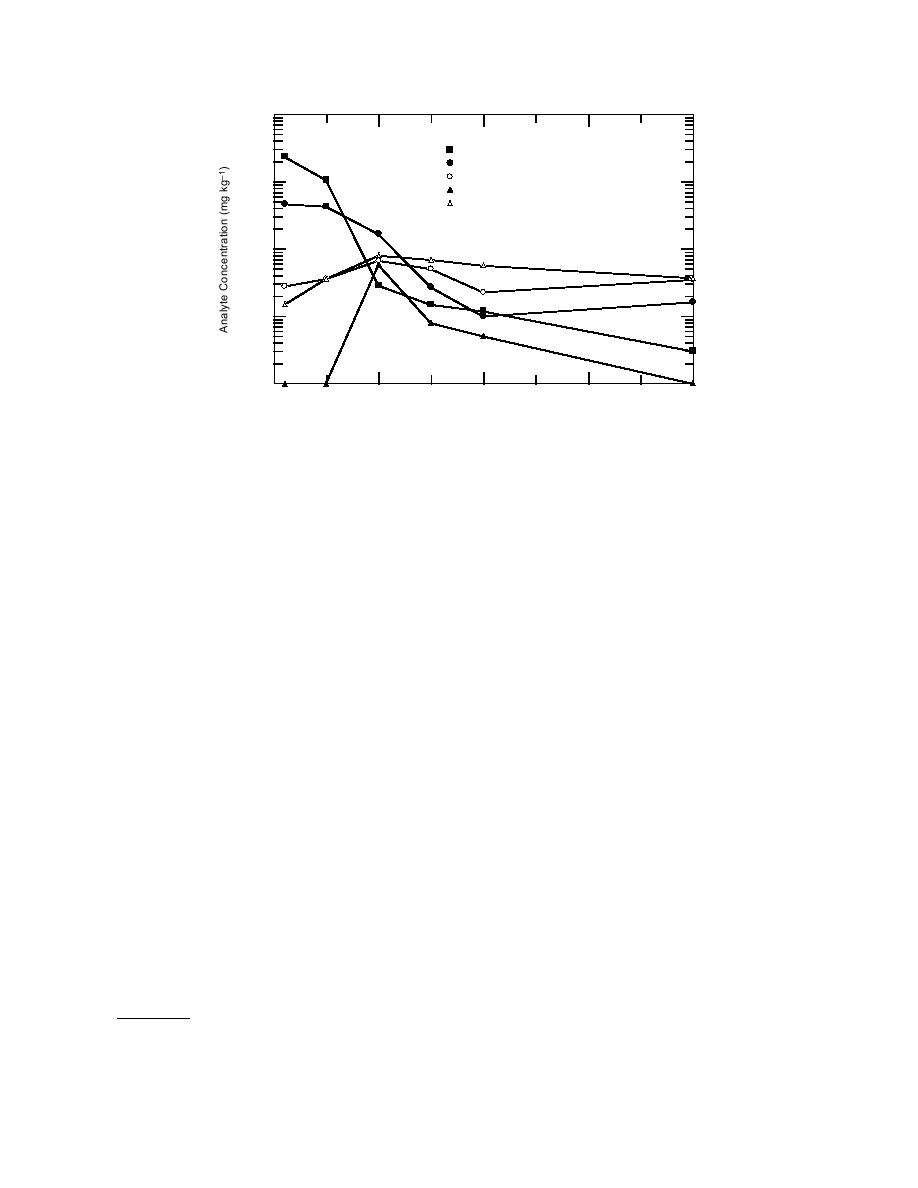
10,000
Solvent-Extractable((Free)TNT
Solvent Extractable Free) TNT
Solvent-Extractable (Free) ADNTs
Extractable (Free) ADNTs
S
Acid-Hydrolyzablle ((Conjugated)ADNTs
yzab e Conjugated) ADNTs
A
1,000
Solvent-Exttracttablle ((Free)DANTs
rac ab e Free) DANTs
S
Acid-Hydrollyzablle ((Conjugated)DANTs
yzab e Conjugated) DANTs
A
100
10
1
10
20
30
40
0
Compost Time (days)
Figure 1. Concentration of free (solvent-extractable) TNT and free and conjugated
(acid-hydrolyzable) transformation products recovered from aerated compost.
compared to 70.3 mg/kg). The base hydrolysis
ties of aminodinitrotoluenes and diamino-
released fewer of the ADNTs than were released
nitrotoluenes that were released by hydrolysis
by the acid hydrolysis (19.8 mg/kg compared to
were further reduced from the Day-40 compost
50.1 mg/kg). However, the subsequent acid hy-
(from 37.8 to 8.1 mg/kg and from 38.0 to 5.5 mg/
drolysis of the base-hydrolyzed residues released
kg, respectively), demonstrating that further con-
considerably more of the conjugated transforma-
jugation of these bound residues continues to oc-
tion products (88.8 mg/kg of ADNTs and 284 mg/
cur over time.
kg of DANTs) (Fig. 2). The combination of base/
Acid hydrolysis of solvent-extracted residues
acid hydrolysis increased the total recovery of con-
degrades the matrix substantially, but results in-
jugated ADNTs and DANTs by about a factor of
dicate that no additional TNT, RDX, or HMX is
three over acid hydrolysis alone.
released. The stability of TNT, RDX, HMX, and
Results from acetonitrile extraction of the di-
the ADNTs under conditions used for acid hy-
gester time-series sludges shown in Figure 3 agree
drolysis has been demonstrated using compost
with previous determinations (Tuomi 1995).
residues. These results confirm that solvent extrac-
Analysis of the extracts and hydrolysates revealed
tion removes all free TNT, RDX, and HMX from
a pattern of explosives degradation and transfor-
sorption sites deep within the matrix as previously
mation product conjugation that was similar to
shown for soils (Jenkins and Grant 1987), and con-
that found in the composts.
firm the results for compost obtained by Myers.*
Control composts (composts with the same
starting materials but free of explosives residues)
Base/acid hydrolysis
were also extracted, hydrolyzed, and analyzed.
Base/acid hydrolysis experiments were per-
Retention times and spectra of all peaks, includ-
formed using Day-15 aerated compost and a time
ing the unretained solvent peak, were compared
series of digester sludge. The quantity of DANTs
to those from sample composts. When this was
released from the Day-15 compost by the base
done, we did not detect any unidentified TNT
hydrolysis was roughly equal to the amount re-
transformation products released by hydrolysis.
leased by the acid-only hydrolysis (57.2 mg/kg
Recoveries
The acetonitrile extractions of sand produced
*Personal communication, K.F. Myers, U.S.
recoveries of RDX, HMX, TNT, and 2ADNT from
Army Engineer Waterways Experiment Station,
92% to 97% (Table 3). Recovery of 4ADNT was
Vicksburg, Mississippi, 1995.
6



 Previous Page
Previous Page
